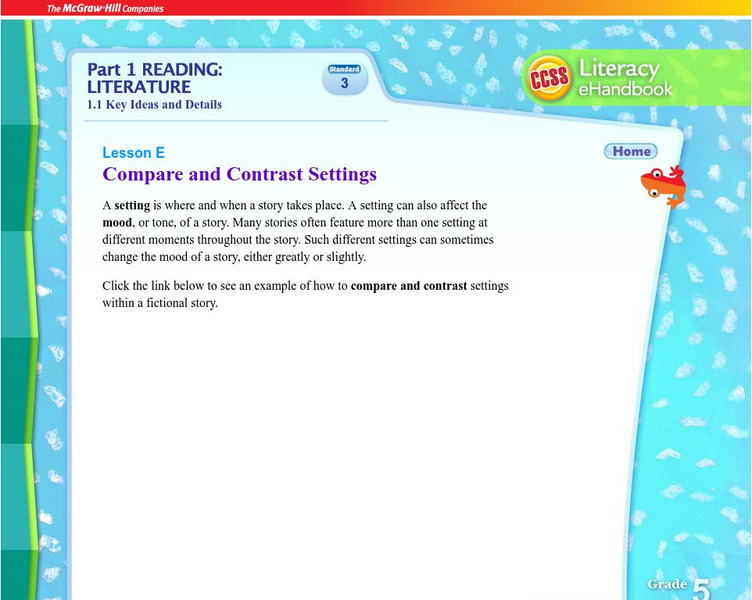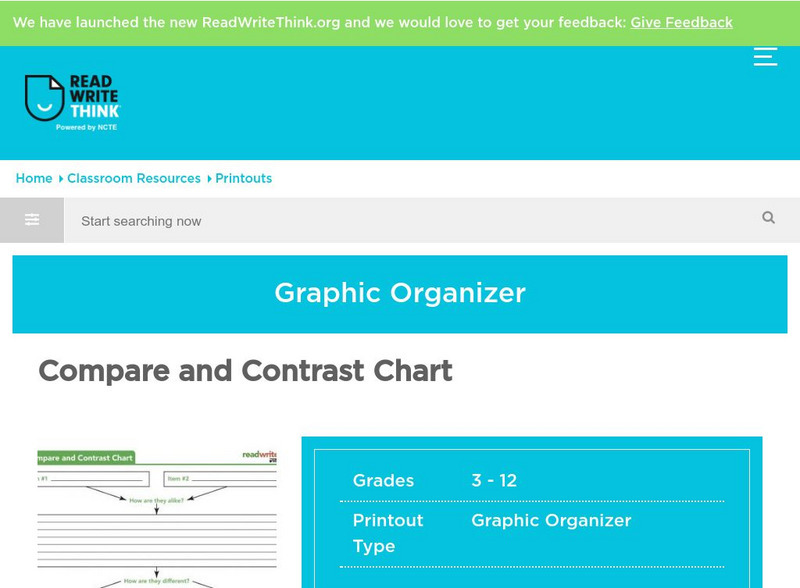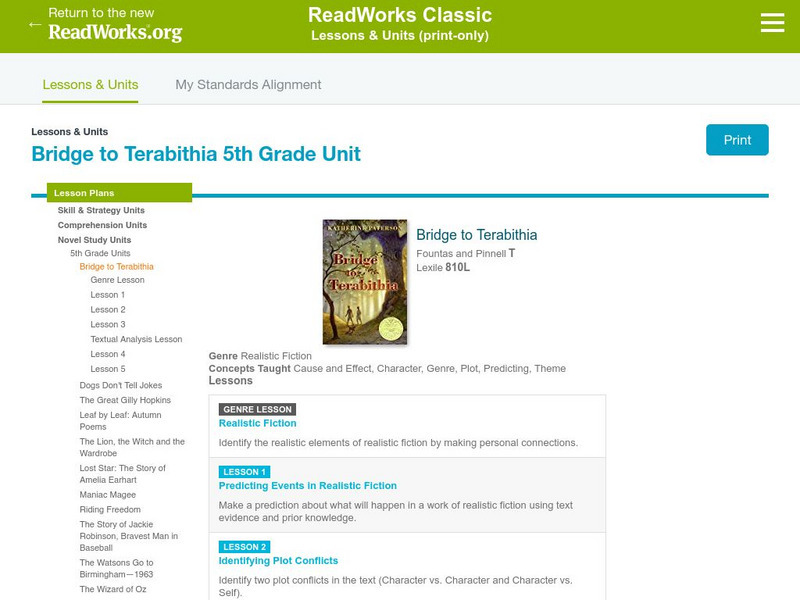Hi, what do you want to do?
Curated OER
Mc Graw Hill: Part 1 Reading: Literature: Compare and Contrast Settings
To comprehend a story, students need to be able to compare and contrast the setting. Learn how to compare and contrast setting in this reference article.
Better Lesson
Better Lesson: Discussing "The True Story of the Three Little Pigs"
In this lesson, 1st graders will work with "The True Story of the Three Little Pigs" Jon Scieszkaby. They will describe the characters, setting, and key details in the story and help the teacher record the details on a circle map.
Sophia Learning
Sophia: Background vs. Integral Setting
This lesson compares background (settings that do not affect the story) and integral settings (the story depends on the setting to make sense).
ReadWriteThink
Read Write Think: Compare and Contrast Map
Use this graphic organizer to compare or contrast ideas, things, or texts. This is a great cross-curricular tool to use for both reading strategies and prewriting.
Texas Education Agency
Texas Gateway: Compare/contrast Themes and Genres in Literary Texts
Determining the theme is not easy; you have to use the clues the author leaves to figure it out yourself. The author implies information about the story through plot points, setting, and characters. You infer and draw conclusions based...
Alabama Learning Exchange
Alex: Exploring the World of Cinderella Tales
Students will read three different Cinderella tales, including tales from Africa, China, and America. Upon completion of a Venn diagram comparing the similarities and differences of these tales, the students will complete and present...
National Endowment for the Humanities
Neh: Edsit Ement: Fairy Tales Around the World
This collection of activities gives students a chance to discover and compare fairy tales from around the world. It provides a wealth of links to resources, printable diagrams, discussion questions and the like.
Quia
Quia: Compare/contrast Character, Plot, and Setting Test
This interactive activity assesses students' understanding of the story elements. Students will read passages that include a short story and a brief drama; then students will answer assorted questions associated to each piece.
Education.com
Education.com: Rl.3.9 Worksheets: Compare and Contrast the Themes, Settings,
[Free Registration/Login Required] Links to 18 worksheets that can be downloaded and printed. Each worksheet focuses on skills highlighted in standard RL.3.9: Compare and contrast the themes, settings, and plots of stories written by the...
Art Institute of Chicago
Art Institute of Chicago: Art Access: Write a Short Story
Compare and contrast two works of art that show groups of people in two different settings. Then choose one of the paintings to write a short story.
Alabama Learning Exchange
Alex: Using a Fairy Tale to Teach the Elements of a Story
Students will hear and read different versions of a familiar fairy tale and identify what elements a story must have (character, plot, setting) for the story to be interesting and make sense. Using a Venn diagram, students will then...
Alabama Learning Exchange
Alex: Fried Green Tomatoes & Cultural Crossroads
Having read Fannie Flagg's Fried Green Tomatoes at the Whistle Stop Cafe, students will conduct research through an interview with an elderly person from the community (a field trip to local nursing home facility) to determine the...
PBS
Pbs Learning Media: Modern Rumpelstiltskin: Video
As you watch this modern story of Rumpelstiltskin, take note of the characters, setting, and what happens in the story. Check out the additional activities below for the classroom and home, and watch the "Guided Viewing" version for...
Read Works
Read Works: Primary Source Texts About Slavery
[Free Registration/Login Required] This nonfiction passage provides two stories about slaves in America with question sets. This passage uses primary source documents to teach reading skills including comparing and contrasting.
PBS
Pbs Learning Media: Modern the Emperor's New Clothes: Video
As you watch this modern version of The Emperor's New Clothes, take note of the character's personalities, how these characters interact, and how they are similar or different from one another. Check out the additional activities below...
Better Lesson
Better Lesson: Speaking, Listening and Writing Compound Contrasting Sentences
Students will be answering text-dependent questions in which they will have to describe the differences between the different characters, settings, and major events in our stories using complex contrasting sentences. The students will...
Utah Education Network
Uen: Lesson Plan: Why Do We Need Rules?
Lesson that helps young scholars understand why rules are needed. Students discuss the story Know and Follow Rules by Cheri J. Meiners, compare the rules in the book to rules at home and at school, and develop a list of rules for the...
Other
Hubbard's Cupboard: If You Give a Mouse a Cookie
Math and literacy meet in this extensive lesson plan based on the familiar children's story, "If You Give a Mouse a Cookie." Learners will be engaged in math activities such as, "Cookie Count," "Who Took the Cookies," and "Cookie Jar...
PBS
Pbs Teachers: Jason and the Golden Fleece
Explore characterization, plot and setting and compare these elements in mythology and modern works of literature, film and television. Retell myths in modern settings or modern-day stories using a mythological Greek setting. While this...
Quizlet
Quizlet: R.3 Analyze How and Why Individuals, Events, or Ideas, Develop/interact
Please align to CCSS.ELA-Literacy.CCRA.R.3 Analyze how and why individuals, events, and ideas develop and interact over the course of a text.
PBS
Pbs Learning Media: The Emperor's New Clothes: Text
This is adapted from Hans Christian Andersen's tale, "The Emperor's New Clothes" in text format.
PBS
Pbs Learning Media: Rumpelstiltskin: Text
This is an adaptation of the fairy tale "Rumpelstiltskin" in text form.
Read Works
Read Works: Bridge to Terabithia 5th Grade Unit
A Grade 5 literature study unit for the novel "Bridge to Terabithia" by Katherine Paterson. The concepts covered include cause and effect, character, genre, plot, predicting, and theme.
Library of Congress
Loc: Immigration and Oral History
The primary goal of this activity is to give learners the genuine experience of oral history in order to appreciate the process of historiography. We identified immigrants in our community who reflect the ethnic diversity of our student...






















